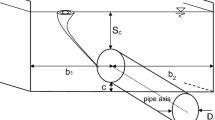Abstract
Braking system is one of the basic organs to control a car. For many years, the disc brakes have been used in automobiles for safe retardation of the vehicles. During braking, enormous amount of heat will be generated, and for effective braking, sufficient heat dissipation is essential. The specific air flow surrounding the brake rotor depends on the thermal performance of the disc brake and hence, the aerodynamics is an important in the region of brake components. A CFD analysis is carried out on the braking system as the study of this case, to make out the behavior of air flow distribution around the disc brake components using ANSYS CFX software. The main object of this work is to calculate the heat transfer coefficient (h) of the full and ventilated brake discs as a function of time using the CDF analysis, which will be used later in the transient thermal analysis of the disc in ANSYS Workbench 11.0.
Similar content being viewed by others
References
T. Valvano and K. Lee, An analytical method to predict thermal distortion of a brake rotor, SAE 2000-01-0445 (2000).
P. Dufrénoy, Two-/three-dimensional hybrid model of the thermomechanical behaviour of disc brakes, J. Rail Rapid Transit Part F, 218 (2004) 17–30.
A. Söderberg and S. Andersson, Simulation of wear and contact pressure distribution at the pad to-rotor interface, in the disc brake using general purpose finite element analysis software, Wear, 267, 12 (1) (2009) 2243–2251.
T. Mahmoudi, A. Parvizi, E. Poursaeidi and A. Rahin, Thermo-mechanical analysis of functionally graded wheelmounted brake disk, J. of Mech. Sci. and Technol., 29 (10) (2015) 4197–4204.
A. Öz, H. Gürbüz, A. K. Yakut and S. Sağiroğlu, Braking performance and noise in excessive worn brake discs coated with HVOF thermal spray process, J. of Mech. Sci. and Technol., 31 (2) (2017) 535–543.
W. Choi, S. Kim, S. Choi and E. Lee, Pad surface and coefficient of friction correlation analysis during friction between felt pad and single-crystal silicon, J. of Mech. Sci. and Technol., 30 (7) (2016) 3113–3118.
C. H. Gao and X. Z. Lin, Transient temperature field analysis of a brake in a non-axisymmetric three-dimensional model, J. Materials Processing Technology, 129 (2002) 513–517.
S. Lee and T. Yeo, Temperature and coning analysis of brake rotor using an axisymmetric finite element technique, Proc. 4th Korea-Russia Int. Symp. on Science & Technology, 3 (2000) 17–22.
K. S. Park, J. P. Won and H. S. Heo, Thermal flow analysis of vehicle engine cooling system, J. of Mech. Sci. and Technol., 16 (7) (2002) 975–985.
S. B. Park, K. S. Lee and D. H. Lee, An investigation of local heat transfer characteristics in a ventilated disc brake with helically fluted surfaces, J. of Mech. Sci. and Technol., 21 (2007) 2178–2187.
W. S. Chung, S. P. Jung and T. W. Park, Numerical analysis method to estimate thermal deformation of a ventilated disc for automotives, J. of Mech. Sci. and Technol., 24 (11) (2010) 2189–2195.
M. Duzgun, Investigation of thermo-structural behaviors of different ventilation applications on brake discs, J. of Mech. Sci. and Technol., 26 (1) (2012) 235–240.
A. Belhocine and M. Bouchetara, Thermal behavior of full and ventilated disc brakes of vehicles, J. of Mech. Sci. and Technol., 26 (11) (2012) 3643–3652.
Z. Luo and J. Zuo, Conjugate heat transfer study on a ventilated disc of high-speed trains during braking, J. of Mech. Sci. and Technol., 28 (5) (2014) 1887–1897.
T. Mahmoudi, A. Parvizi, E. Poursaeidi and A. Rahi, Thermo-mechanical analysis of functionally graded wheelmounted brake disk, J. of Mech. Sci. and Technol., 29 (10) (2015) 4197–4204.
E. Ljungskog, S. Sebben, A. Broniewicz and C. Landström, A parametric study on the influence of boundary conditions on the longitudinal pressure gradient in CFD simulations of an automotive wind tunnel, J. of Mech. Sci. and Technol., 31 (6) (2017) 2821–2827.
A. Belhocine and W. Z. Wan Omar, Three-dimensional finite element modeling and analysis of the mechanical behavior of dry contact slipping between the disc and the brake pads, Int. J. Adv. Manuf. Technol., 88 (1–4) (2017) 1035–1051.
A. Belhocine, FE prediction of thermal performance and stresses in an automotive disc brake system, Int. J. Adv. Manuf. Technol., 89 (9–12) (2017) 3563–3578.
L. Zhang, Q. Yang, D. Weichert and N. Tan, Simulation and analysis of thermal fatigue based on imperfection model of brake discs, Beijing Jiaotong University, PAMM Proc. Appl. Math. Mech., 9 (2009) 533–534.
J. Reimpel, Braking Technology, Vogel Verlag, Würzburg (1998).
P. F. Gotowicki, V. Nigrelli and G. V. Mariotti, Numerical and experimental analysis of a pegs-wing ventilated disk brake rotor, with pads and cylinders, 10 th EAEC Eur. Automot. Cong-Paper EAEC05YUAS04-P 5, June (2005).
Author information
Authors and Affiliations
Corresponding author
Additional information
Recommended by Associate Editor Seong Hyuk Lee
Ali Belhocine received his Ph.D. degrees in Mechanical Engineering at the University of Science and the Technology of Oran (USTO Oran), Algeria. His research interests include Automotive Braking Systems, Finite Element Method (FEM), ANSYS simulation, CFD Analysis, Heat Transfer, Thermal-Structural Analysis, Tribology and Contact Mechanic.
Wan Zaidi Wan Omar is now a Senior Lecturer in the Department of Aeronautical, Automotive and Off-shore Engineering, Universiti Teknologi Malaysia. He graduated B.Sc. Engineeing (Aeronautical Eng.) from University of Manchester and M.Sc. Applied Instrumentation and Control from Glasgow Caledonian University. His general research interests are Aircraft Sructures, Aircraft Designand Renewable Energy. His current projects are Design of future ground attack or close air support aircraft, Wind energy systems and Solar powered chiller systems. One of his off-academic end eavour is his fascination with the life and methods of bees - he is now trying to capture a wild honey bee colony from somewhere on Universiti Teknologi Malaysia campus.
Rights and permissions
About this article
Cite this article
Belhocine, A., Omar, W.Z.W. CFD analysis of the brake disc and the wheel house through air flow: Predictions of Surface heat transfer coefficients (STHC) during braking operation. J Mech Sci Technol 32, 481–490 (2018). https://doi.org/10.1007/s12206-017-1249-z
Received:
Revised:
Accepted:
Published:
Issue Date:
DOI: https://doi.org/10.1007/s12206-017-1249-z




